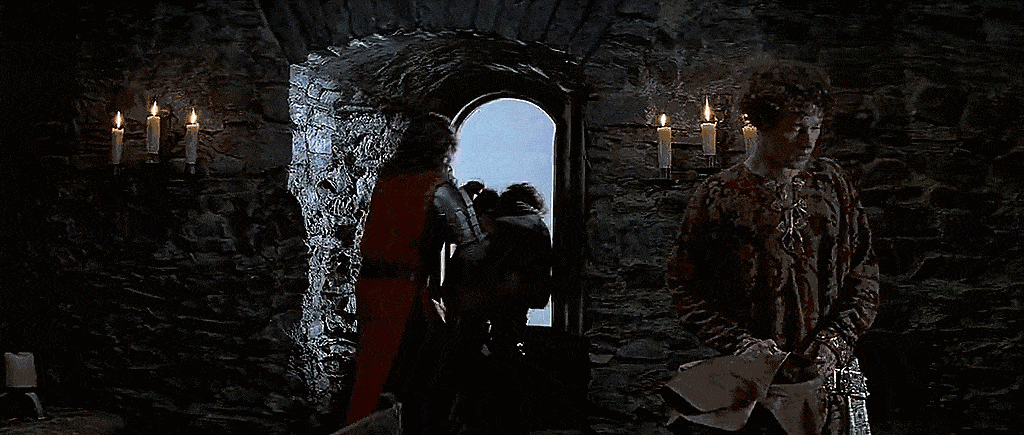Another movie that mangles history.
The Princess was 3 years old.
Wallace was a nobleman, "freedom" my ass. If his peasants revolted for their freedom, guess what their fate would have been?
William Wallace | Biography, Braveheart, Death, Sword, & Facts
Randall Wallace, who wrote the screenplay, has acknowledged
Blind Harry's 15th-century
epic poem The Acts and Deeds of Sir William Wallace, Knight of Elderslie as a major inspiration for the film.
[48] In defending his script, Randall Wallace has said, "Is Blind Harry true? I don't know. I know that it spoke to my heart and that's what matters to me, that it spoke to my heart."
[48] Blind Harry's poem is not regarded as historically accurate, and although some incidents in the film that are not historically accurate are taken from Blind Harry (e.g. the
hanging of Scottish nobles at the start),
[49] there are large parts that are based neither on history nor Blind Harry (e.g. Wallace's affair with Princess Isabella).
[5]
Elizabeth Ewan describes
Braveheart as a film that "almost totally sacrifices historical accuracy for epic adventure".
[50] The "brave heart" refers in Scottish history to that of
Robert the Bruce, and an attribution by
William Edmondstoune Aytoun, in his poem
Heart of Bruce, to
Sir James the Good Douglas: "Pass thee first, thou dauntless heart, As thou wert wont of yore!", prior to Douglas' demise at the
Battle of Teba in
Andalusia.
[51] It has been described as one of the most historically inaccurate modern films.
[5]
Sharon Krossa noted that the film contains numerous historical inaccuracies, beginning with the wearing of
belted plaid by Wallace and his men. In that period "no Scots [...] wore belted plaids (let alone
kilts of any kind)." Moreover, when Highlanders finally did begin wearing the belted plaid, it was not "in the rather bizarre style depicted in the film". She compares the inaccuracy to "a film about Colonial America showing the colonial men wearing 20th century business suits, but with the jackets worn back-to-front instead of the right way around."
[52] In a previous essay about the film, she wrote, "The events aren't accurate, the dates aren't accurate, the characters aren't accurate, the names aren't accurate, the clothes aren't accurate—in short, just about nothing is accurate."
[53] The belted plaid (
feileadh mór léine) was not introduced until the 16th century.
[54] Peter Traquair has referred to Wallace's "farcical representation as a wild and hairy highlander painted with
woad (1,000 years too late) running amok in a
tartan kilt (500 years too early)."
[55] Wallace was a lowlander, so the mountains and glens of his home as depicted in the film are also inaccurate.
Irish historian Seán Duffy remarked "the
battle of Stirling Bridge could have done with a bridge."
[56]
In 2009, the film was second on a list of "most historically inaccurate movies" in
The Times.
[5] In the humorous non-fictional historiography
An Utterly Impartial History of Britain (2007), author
John O'Farrell claims that
Braveheart could not have been more historically inaccurate, even if a
Plasticine dog had been inserted in the film and the title changed to "
William Wallace and Gromit".
[57]
In the
DVD audio commentary of
Braveheart, Mel Gibson acknowledges many of the historical inaccuracies but defends his choices as director, noting that the way events were portrayed in the film was much more "cinematically compelling" than the historical fact or conventional mythos.
[5]
Braveheart - Wikipedia
The 10 most historically inaccurate movies
Caroline White
1 U-571, 2000
Rather cynically, American screenwriter David Ayer depicted American rather than British naval officers capturing the first Enigma machine, “in order to drive the movie for an American audience.”
2 Braveheart, 1995
Not only was the Scottish hero William Wallace gruesomely executed in 1305, having been captured by the English at Falkirk, but seven centuries later his memory was exhumed, smeared with blue face paint and mutilated by Mel Gibson.
3 10,000 BC, 2008
4 The Patriot, 2000
Gibson (rugby) tackles history again with his turn as an honest farmer drawn into the American Revolutionary War, which historian David Hackett Fischer claimed in the New York Times “is to history as Godzilla was to biology.”
5 Pearl Harbour, 2001
The protagonists of Pearl Harbour, George Welch and Kenneth M. Taylor, are based on two real-life US Army Air Corps Second Lieutenants, but the film weaves such a wildly inaccurate account of their love lives and sky-swooping exploits, that the cinematic incarnations have been rendered fictional. B
6 Apocalypto, 2006
If you thought it strange that Apocalypto’s Mayans ransack a village of their own people for sacrificial victims and slaves, your suspicion was justified.




